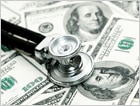April 20, 2011 — The 10 most prescribed drugs in the U.S. aren't the drugs on which we spend the most, according to a report from the IMS Institute for Healthcare Informatics.
The institute is the public face of IMS, a pharmaceutical market intelligence firm. Its latest report provides a wealth of data on U.S. prescription drug use.
Continuing a major trend, IMS finds that 78% of the nearly 4 billion U.S. prescriptions written in 2010 were for generic drugs (both unbranded and those still sold under a brand name). In order of number of prescriptions written in 2010, the 10 most-prescribed drugs in the U.S. are:
- Hydrocodone (combined with acetaminophen) -- 131.2 million prescriptions
- Generic Zocor (simvastatin), a cholesterol-lowering statin drug -- 94.1 million prescriptions
- Lisinopril (brand names include Prinivil and Zestril), a blood pressure drug -- 87.4 million prescriptions
- Generic Synthroid (levothyroxine sodium), synthetic thyroid hormone -- 70.5 million prescriptions
- Generic Norvasc (amlodipine besylate), an angina/blood pressure drug -- 57.2 million prescriptions
- Generic Prilosec (omeprazole), an antacid drug -- 53.4 million prescriptions (does not include over-the-counter sales)
- Azithromycin (brand names include Z-Pak and Zithromax), an antibiotic -- 52.6 million prescriptions
- Amoxicillin (various brand names), an antibiotic -- 52.3 million prescriptions
- Generic Glucophage (metformin), a diabetes drug -- 48.3 million prescriptions
- Hydrochlorothiazide (various brand names), a water pill used to lower blood pressure -- 47.8 million prescriptions.
The 10 Best-Selling Drugs
It shouldn't be a surprise that these generic drugs are not the ones bringing in the big bucks for pharmaceutical companies. The drugs on which we spend the most money are those that are still new enough to be protected against generic competition.
The IMS reports that Americans spent $307 billion on prescription drugs in 2010. The 10 drugs on which we spent the most were:
- Lipitor, a cholesterol-lowering statin drug -- $7.2 billion
- Nexium, an antacid drug -- $6.3 billion
- Plavix, a blood thinner -- $6.1 billion
- Advair Diskus, an asthma inhaler -- $4.7 billion
- Abilify, an antipsychotic drug -- $4.6 billion
- Seroquel, an antipsychotic drug -- $4.4 billion
- Singulair, an oral asthma drug -- $4.1 billion
- Crestor, a cholesterol-lowering statin drug -- $3.8 billion
- Actos, a diabetes drug -- $3.5 billion
- Epogen, an injectable anemia drug -- $3.3 billion
U.S. Prescription Drug Use: 2010 Factoids
Who's paying for all these drugs? Commercial insurance helped pay for 63% of prescriptions, down from 66% five years ago. Federal government spending through Medicare Part D covered 22% of prescriptions.
For Americans covered by insurance, Medicare, or Medicaid, the average co-payment for a prescription was $10.73 -- down a bit from 2009 due to increased use of generic drugs. The average co-payment for branded drugs for which generic alternatives were available jumped 6% to $22.73.
Other facts from the 2010 IMS report:
- Doctor visits were down 4.2% since 2009.
- Patients filled more than half of their prescriptions -- 54% -- at chain drugstores, possibly because of discounts on generic drugs.
- Brands that lost their protection from generic competition led to $12.6 billion less spending in 2010 than in 2009.
- The price increase for drugs without generic competition led to $16.6 billion more spending in 2010 than in 2009.
- Drug companies offered $4.5 billion in rebates to assist patients with the high cost of brand name drugs for which there was no generic alternative.
SOURCE:
IMS Institute for Healthcare Informatics: "The Use of Medicines in the United States: Review of 2010," April 2011.



 But caregivers can take various steps to protect their health, says Rebecca Axline, a clinical social worker at the Nantz National Alzheimer Center in Houston.WEDNESDAY, April 27 (HealthDay News) -- The growing number of people with Alzheimer's disease in the United States means that more people are becoming caregivers, a responsibility that health experts warn can pose risks to body and mind.
But caregivers can take various steps to protect their health, says Rebecca Axline, a clinical social worker at the Nantz National Alzheimer Center in Houston.WEDNESDAY, April 27 (HealthDay News) -- The growing number of people with Alzheimer's disease in the United States means that more people are becoming caregivers, a responsibility that health experts warn can pose risks to body and mind.



